Tsuchinoko
Posted by: Loren Coleman on October 10th, 2009
While I’m in the midst of the 2009 move of the International Cryptozoology Museum, here’s a re-visit with a Japanese cryptid of some note, from 2008, by Loren Coleman (not Brent Swancer, wink wink), with my adding of a few more popular cultural details I wanted to add the first time.
The Tsuchinoko (ツチノコ), is a legendary land-dwelling serpent-like cryptid from Japan. The name tsuchinoko is prevalent in Western Japan, including Kansai and Shikoku; the creature is known as bachi hebi in Northeastern Japan.
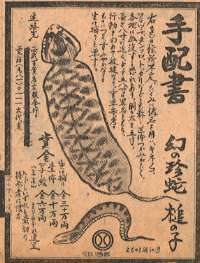
Tsuchinoko are described as being between a foot to 32 inches (30 and 80 centimeters) in length, similar in appearance to a snake, but with a central girth that is much wider than its head or tail. It is deadly, said to have fangs and venom similar to that of a viper.
Some accounts also describe the Tsuchinoko as being able to jump up to a three feet (a meter) in distance.
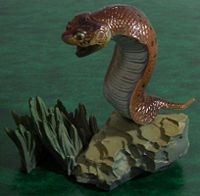
Various replicas, some as toys (above) and others as more formal pieces (below) have been produced.
German cryptozoologist Sordes shared the following in 2008:

I finally managed to make my first casts of one of my crypto-models, a Tsuchinoko.
His new models look like this:
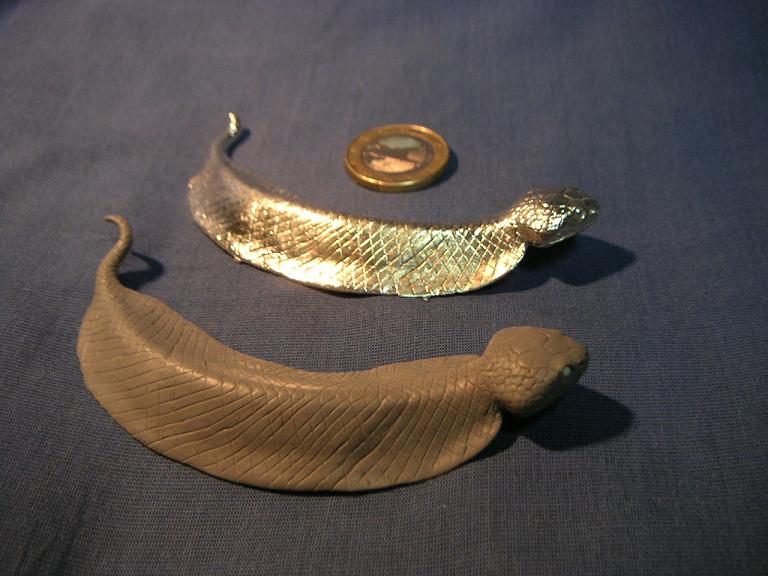
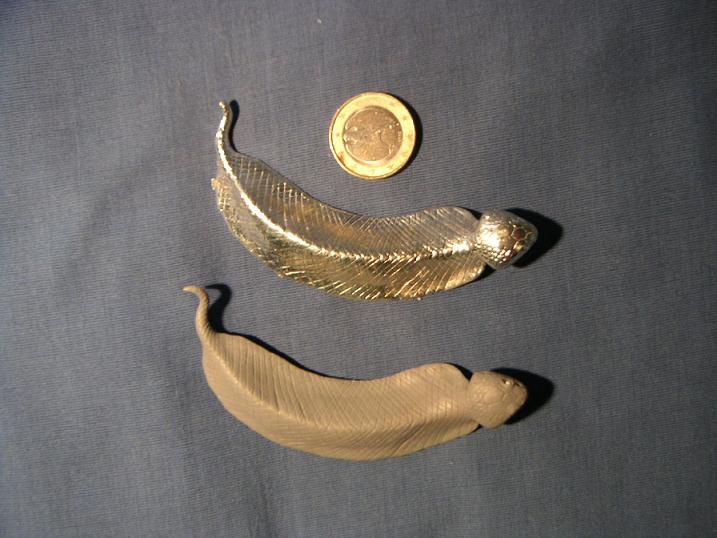
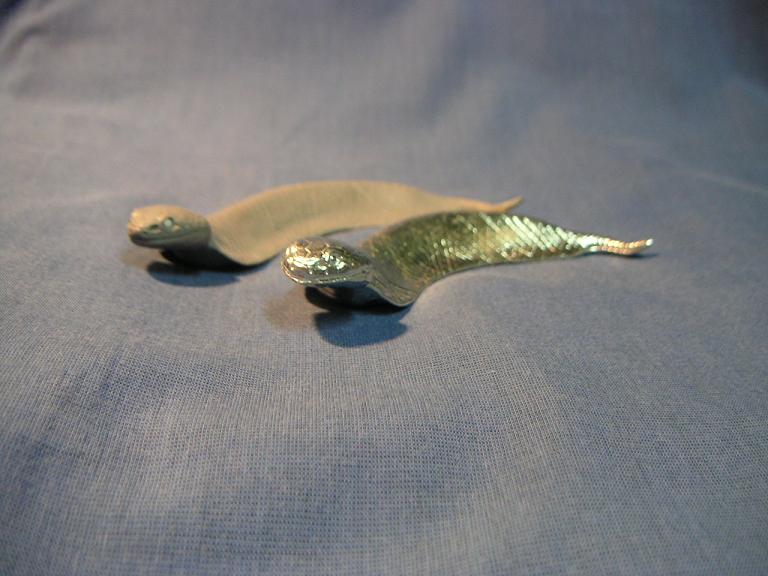
For more in German, go here.
For further recent background, please note that in the Top Cryptozoology Stories of 2000, the #4 pick was for the “Search for the Tsuchinoko”:
In 2000, Yoshii, Okayama, Japan was in the news again, as people were flocking to the region to hunt for the tsuchinoko, a chirping reptile-like cryptid bearing at least some resemblance to a snake or a long, thick lizard. A 20 million yen reward from the Yoshii Municipal Government was the source of all the excitement.
Tsuchinoko fever hit Yoshii on May 21 after a farmer cutting grass swore he saw a snake-like creature with a face resembling the cartoon cat Doraemon slither across his field. The farmer slashed the creature with his weed whipper, but it fled into a nearby stream and escaped. Four days later, 72-year-old Hideko Takashima was talking with a couple of friends in Yoshii when she found what she thought was one of the creatures lying dead next to the stream a tsuchinoko reportedly had dived into to escape from the farmer. She picked it up and buried it.
Yoshii Municipal Government officials heard the rumors of a tsuchinoko and headed out to look over the local woman’s find. They exhumed the body and forwarded it to Kawasaki University of Medical Welfare to be examined. Kuniyasu Sato, the professor who analyzed the reptile, said that the animal may indeed have been the tsuchinoko, but “scientifically speaking, it was a kind of snake.”
Meanwhile, Mitsuko Arima, an 82-year-old from Yoshii, says she saw a Tsuchinoko swimming along a river on the morning of June 15.
“I was surprised. I just pointed at it and asked ‘Who are you? Who are you?’ It didn’t answer me, but just stared. It had a round face and didn’t take its eyes off me. I can still see the eyes now. They were big and round and it looked like they were floating on the water,” Arima says. “I’ve lived over 80 years, but I’d never seen anything like that in my life.”
No one collected the reward in 2000.
Meanwhile, on the popular cultural front in America….

The rock group Kayo Dot, which came to play in Portland six years ago, visited me while here. The band is headed by Toby Driver and Mia Matsumiya. Mia Matsumiya is a big fan of cryptozoology (uses “coelacanthm” as her live journal name) and the band has a tee-shirt with a leaping Tsuchinoko on it, from original art from 2003. Since I can’t find any images of the tee-shirt, I’ll share images of the beautiful Mia.


Perhaps Kayo Dot will play a benefit for the International Cryptozoology Museum, someday. And the leaping Tsuchinoko Kayo Dot shirts can be brought back into being?
About Loren Coleman
Loren Coleman is one of the world’s leading cryptozoologists, some say “the” leading living cryptozoologist. Certainly, he is acknowledged as the current living American researcher and writer who has most popularized cryptozoology in the late 20th and early 21st centuries.
Starting his fieldwork and investigations in 1960, after traveling and trekking extensively in pursuit of cryptozoological mysteries, Coleman began writing to share his experiences in 1969. An honorary member of Ivan T. Sanderson’s Society for the Investigation of the Unexplained in the 1970s, Coleman has been bestowed with similar honorary memberships of the North Idaho College Cryptozoology Club in 1983, and in subsequent years, that of the British Columbia Scientific Cryptozoology Club, CryptoSafari International, and other international organizations. He was also a Life Member and Benefactor of the International Society of Cryptozoology (now-defunct).
Loren Coleman’s daily blog, as a member of the Cryptomundo Team, served as an ongoing avenue of communication for the ever-growing body of cryptozoo news from 2005 through 2013. He returned as an infrequent contributor beginning Halloween week of 2015.
Coleman is the founder in 2003, and current director of the International Cryptozoology Museum in Portland, Maine.










Thanks for the advertising Loren! It’s really nice to see the photos of my model at cryptomundo. As the model is very small and the surface very bright, it was hard to make good detailed photos, and as they are not coloured, they are still a bit boring. I tried really my best to make it as accurate as possible and made a lot of research to make the positioning of the scales at the head like those of a real otter. As the model is only very small, the rest of the scales are sadly not that nice, what was also a result of the curved body.
I’m surprised no photos of the dead specimen have been released. If it looked anything like the picture and replicas seen here, it is definitely a kind of snake, most likely a pit viper. In my opinion,it looks alot like the death adders of Australia, which are actually members of the cobra family. Its jumping abilities are probably somewhat exaggerated.
There are at least five known species of “FLYING” snakes (genus Chrysopelea), from Southeast Asia, that flatten their bodies out to glide through the air.
Could the Tsuchinoko represent a new species?
A new species of flying snake would be an exciting discovery to herpetologist.
I looked up the tsuchinoko and some people seem to think it’s based on sightings of snakes that have recently swalllowed something big.
I don’t know much about far East mythology, but I think it was Japan I was learning about in class. They used to draw tigers with strange flattened faces because the only specimens they had were from skinned animals, thus they had to guess the shape of the face from deformed and desecrated skins. Maybe this is just a beautiful snakes skin, taken from a live snake shedding or a dead specimen, that has then been interpreted in art? Please correct any incorrect locations or if people know more about this than I do, it just might be a valid observation.
The tsuchinoko has been around in Japan for quite a long time. Its in the Kojiki which is the oldest book here in Japan. Most of the book is in Chinese characters and there are few names and phrases in Japanese. It seems like folklore to me. Just like the tanuki and the bake neko. A Doraemon head? He has a very round head. I cannot imagine a snake that looks like that. Seems more like a lizard than a snake. But regardless the tsuchinoko has been sighted since the Jomon period (13,000 BC I think) and will probably continue to be sighted in mainland Japan until proved or disproved.
Wow, I’m gone for a couple of weeks and one of my favorite Japanese cryptids springs up on the site while I’m gone! The folklore behind this snake is amazing and goes back a very long time throughout recorded history. The presence of the tsuchinoko is still very much alive in modern popular culture over here in Japan, and it pops up in everything from children’s books, to advertising, to video games. It is known by pretty much everyone, but interestingly enough I have not met very many people here who think it actually exists.
Although I have an open mind, I myself am a bit on the skeptical side of the actual existence of a new species of snake fitting the description provided from reports and the lore for several reasons. First, the description of the snake is always of one that is fat in the middle and fairly hardy and heavy looking, not at all the type of design I would think would be conducive to making the several meter long leaps it is reportedly capable of. Also, the snake is said to be capable of a wide range of vocalizations of the type that would be very odd for a snake to have developed. Some even say it is capable of mimicking a human voice. I won’t even get into the magical properties attributed to it through the ages.
These things in and of themselves probably do not rule out a new species of snake as we all know that native accounts of real ethnoknown species can often have some somewhat fantastic descriptions and yet they are based on an actual animal. I just think there are some possible mundane explanations for a lot of the sightings. Someone here already mentioned that the description of a fat middle body could possibly be caused by a snake that has recently fed. The jumping ability could be exaggerated, or a misrepresentation of some other form of unusual locomotion such as can be seen in the “sidewinder” snakes. The vocalizations said to be made by the snake could be exaggerated, the product of an overactive imagination, or even be caused by other strange sounds caused by something else during the sighting, and then mistakenly attributed to the snake. If there is a new type of snake in Japan, I feel it almost certainly cannot do everything it is said to be able to do and it would be interesting to see just what it CAN do and how it does move.
In the end, I am open to the idea of a new species of snake in Japan, but it is hard to say if this is the case when it comes to the tsuchinoko. It is hard to tell where any real creature might begin and where myth and folklore ends and so I think a critical approach should be taken. It could be a real snake, colored by folklore, I will not rule that out yet I think more mundane possibilities need to be looked at as well. Nevertheless, there are groups in Japan still actively searching for the snake and there are occasional rewards offered for a specimen, so who knows? Maybe it is the next new species waiting to be found.
The tsuchinoko is interesting in that it is so seeped with folklore going back throughout history and such a pop cultural icon in Japan, yet there seem to be relatively few people here who I have personally met who actually entertain the thought that they are a real animal.
I am very enamored with the stories of the tsuchinoko and the myths and folklore associated with it, indeed it is one of my favorite Japanese cryptids, yet I remain on the skeptical side as to its actual existence. To me, there are some key points that need to be looked at critically concerning the way the animal is typically described.
First off, the tsuchinoko is renowned for its ability to make great leaps of several meters. This is interesting as the snake is always described as quite thick in the middle, quite sturdy and heavy looking, which is not a good design for making such jumps. What to make of this? There was a good comment on the so called “flying snakes”, and this could offer a possible explanation, although accounts are quite clear that the snakes are jumping horizontally from a set position rather than gliding. It could also be the result of exaggeration or a misidentification of some other form of locomotion such as the “sidewinding” that some snakes do, or a particularly explosive strike at prey. And if you think the leaping is an odd feature, consider that there are reports of the snake taking its tail within its mouth and rolling along like a wheel.
Second is the shape of the snake, which as I mentioned is very thick in the middle. As someone else mentioned, this could very easily be caused by the witness seeing a recently fed snake. There was even a case some years back where someone claimed to have captured a tsuchinoko and it turned out to be just a gorged common variety of snake.
Third is the purported cases of the tsuchinoko’s wide range of vocalizations that range from whistles, to grunts, to chirping. Some accounts tell of their ability to even mimick a human’s voice. I feel this sort of vocal range would be odd for a snake to have developed, and I think instead this might be more exagerration or confusion of another sound for one made by the snake.
There are other reported seemingly magical abilities of the tsuchinoko as well, and so like other Japanese animals both real and imagined, I think it is sometimes hard to tell where the folklore ends and the facts begin. If there is a new species of snake out here in Japan, I am doubtful that it can do everything it is reportedly able to do. Of course there have been animals before that were very real despite being given fantastic or even supernatural descriptions, so I do not wholly rule out the existence of a new type of snake in Japan. There are groups out there who still actively search for the tsuchinoko and I would be thrilled for them to turn up a new reptile. I just think the more mundane possible explanations have to be given weight as well.
Mystery Man; thanks for the comprehensive description of the beast. It’s good to know that among the professionals there are some who appreciate that somethings go unseen, overlooked, and otherwise ignored.
You say that there is a group who seek it. Is there a general approach that they take? Not having been to Japan, yet, I wonder where I’d plan an expedition to look, actually it would be more like a pretext to get outta town and hang. Cheers.
PS, have you read Charles Mann’s “1491”? I am now and it’s altering my understanding of the way field science (archaeology and paleoanthropology in this case) and its interpretation work in the real world with some surprising new revelations.
Dogu4- I do not have a completely intimate knowledge of the organizations that look for the tsuchinoko, but as far as I can tell, these groups seem to mostly be involved in very much the weekend warrior type of excursion as there doesn’t seem to be a lot of money pouring into such things. I imagine these people are very much like Bigfoot hunters who work out of their own pockets in their own free time, and unfortunately that is probably going to hamper any results. They do seem to be thorough about following up sightings reports and searching in likely locations, but unfortunately I cannot say for sure how scientific their research methods are. As to the book you mentioned, I have not read it yet, but I have been meaning to!
MM, I also find interesting the supposed ability to mimic human voices. I’ve noticed that this is also claimed for various mythical beasts around the world, such as the Lamia. I agree that is a highly unlikely ability though, and probably is based on the similarity various animal and bird calls have to human sounding moans, screams, etc. The barn owl is a good example, I think. Since one seldom sees an animal when such calls are made, it is easy to assign a variety of sounds to one animal over a period of time.
Finally, here’s a bit of cultural speculation: What do you think of the idea (just occurred to me) that the proportions of the tsuchinoko being an influence on the development of that peculiar style of anime called SD or Super Deformed?
Ceroill- Whoa, I hadn’t realized people were still posting on this thread, so I missed your comment. Sorry for the late reply.
As to your idea on the development of the human voice of the tsuchinoko, I think what you said is spot on. Sure, there are animals, like parrots, that are capable of being great mimics but snakes are not exactly known for that sort of thing. I think any of the vocalizations described for the tsuchinoko would be highly unusual for a snake, let alone human voices.
Concerning your inquiry on Japanese anime, I have to first off admit that this is one aspect of Japanese culture that I am not particularly well versed in, so I would have rather had someone here who is more knowledgable on the subject to answer your question. However in my opinion (I do have a passing knowledge), anime styles such as “super deformed” reflect a wide array of cultural aspects and sensitivities. So while I don’t think the tsuchinoko is the sole inspiration for that style, I wouldn’t be surprised if it had some influence. That is an interesting cultural observation you made, I only wish I was more informed to give you a better and more concise answer!
I am suddenly struck with the thought of wondering what potential cryptid beasties might exist in the old Ainu traditions.
It looks a lot like a planarian, except for the size. Flatworms can’t get very thick, but maybe they could grow longer and wider than the typical planarian.
Thanks for the information, Mystery_Man.
That WAS a thought-provoking question Ceroill asked. Given that the Anime field is so vast and “complex,” I don’t blame you for not having an answer.
On a “unrelated” note:
Those are some good-looking women there at Kayo Dot. 🙂